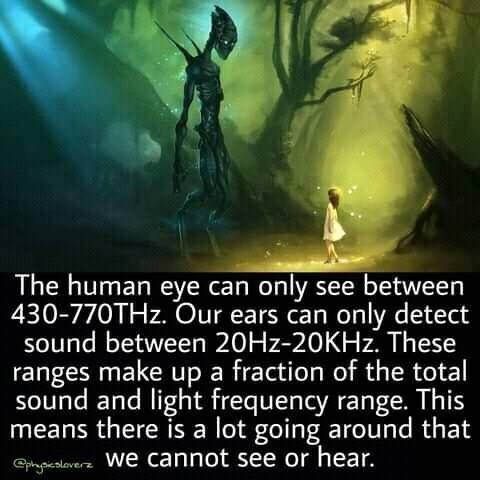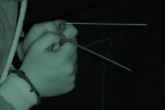Paranormal Meme Claims We Only Perceive A Fraction Of The World Around Us
November 06, 2022 1:00 AM ‐ Science
This article is more than one year old.

Photo: pixabay.com
A meme that has been shared by countless paranormal groups on Facebook claims that the frequency ranges of light and sound that humans can perceive only give us a limited view of the world around us.
The meme reads "the human eye can only see between 430-770THz. Our ears can only detect sound between 20Hz-20KHz. These ranges make up a fraction of the total sound and light frequency range. This means there is a lot going around that we cannot see or hear."

The first problem with this image, the standard type people create using a meme maker, is that it implies that sound and light are part of the same spectrum. They are not. Although they are both measured in Hertz in this context, they are both very different. In the case of light, its frequency is the measure of the speed its waveform travels. Sound however is a vibration that travels through a medium like the air, in this case the frequency is a measure of how fast the air is vibrating.
It is true that our view of the world is limited, but what lies beyond what we can see and hear isn't a mystery. For the most part it is measurable and very well understood. It's even taught as part of high school science lessons, but from time to time, we all need a refresher.
Light
The claim that the human eye can only see between 430-770THz is pretty accurate, but what the meme gets wrong is claiming that this is just a fraction of the light frequency range. In fact this 430-770THz range is the visible light frequency.
However, visible light is only a fraction of the electromagnetic spectrum. Beyond this visible frequency range are invisible things like infrared, ultraviolet, radio waves, microwaves and even heat. So there is nothing mysterious about the rest of the spectrum that is not visible to us, in fact it is all detectable or measurable in some way.
What the meme also fails to understand is that even if we could see more of the electromagnetic spectrum with our eyes, it doesn't mean that we'd be able to see more things around us.
For example, you are probably sat reading this in a room filled with white light. Imagine you replace that lightbulb with a red bulb. What you've done here is decreased the visible light range that's available to you, but decreasing available light doesn't change the physical objects around you. You don't see less when the visible light range is decreased, you just see it in a different colour.
Similarly, if you've ever used a night vision camera on a ghost hunt then you'll know that these cameras use infrared to see in the dark. Infrared is a great example of a part of the electromagnetic spectrum that we can't see, but it doesn't allow the camera to see things that we can't'. It just allows it to see the same things as we can in different conditions - total darkness. Turn your flashlight on and you'll be able to see exactly the same thing as the camera sees.
This is because the physical world around us isn't made of light, it merely reflects light into our eyes enabling us to see what's around us. In fact, the reason visible light is visible is because its wavelength is such that it can bounce off of objects and interact with our eyes. If the wavelength is too short, like in the case of gamma rays, they pass through the space within the atoms of the object rather than being reflected. On the other hand, if the wavelength is too big, your eye would need to be big to detect them, which is true of radio waves.
Sound
In the case of sound, the claim that we can only hear sounds with a frequency between 20Hz-20KHz is true, and it's correct that the frequency range does expand beyond this but aren't audible to the human ear.
Paranormal investigators sometimes forget that when talking about sound, "frequency" means "pitch" or "tone". So, a sound at 20Hz is very deep and low, while a 20KHz sound is an uncomfortable high-pitched whine. These low frequency tones are called infrasound, and high pitch sounds are called ultrasound.
Both infrasound and ultrasound can be recorded using specialist, and usually expensive, recording equipment. So although we can't hear the whole range with our ears, we can measure it and even record it. These sounds can be pitch adjusted and played back to us within a frequency range we can hear, a good example of something that does this is a bat detector.
So there is nothing mysterious lurking outside the human audible range, just some very low pitched or very high pitched sounds that aren't important to us in our day-to-day lives.
Related Content
Daily Horoscopes
You May Also Like
























